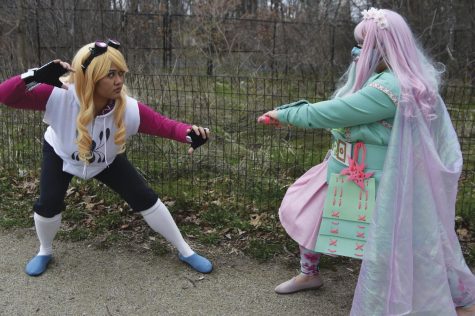Cosplayers find creativity and community by reinventing their pop culture alter egos
June 24, 2022

Editor’s note: This article is from the Communication Department’s award-winning Echo magazine.
After a quick trip to Party City 10 years ago, Christopher English donned a plastic wig, some red face paint and an out-of-the-bag costume, and put an empty paint can over his right hand to represent Hellboy’s Hand of Doom. He went to a comic book convention and saw people in elaborate costumes representing hundreds of different characters.
“I was like, ‘I want to do this all the time, I want to do this every weekend,’” English says. “And that’s when I found out that it’s called cosplay.”
Cosplay (short for costume play) is a performance art form where people create elaborate costumes that mimic their favorite characters in movies, TV shows and comics.
Since English’s first convention, he has created about 50 to 60 costumes, taking anywhere from a week or a year to create, and costing anywhere from $600 to $1,000.
English wears his costumes to conventions, movie premieres and advanced screenings, libraries and charity events.
Chicagoan Monica Paprocki professionally creates costumes for companies. She also competes, participating in the Crown Championships of Cosplay in Chicago.
Paprocki, who works as an accountant, says she always knew she wanted to be an artist. She has a degree in psychology and accounting, but always knew she would return to art. After entering a contest hosted by Marvel Comics in which she dressed up as Galacta, daughter of Galactus, Paprocki found her way back to art.
She says she fell in love with the way cosplay mixes fashion and architecture.
“I got hooked doing competitions because of the technical aspects of putting that stuff together,” Paprocki says. “On top of just showing off my creativity that way, was just a whole other level of something that I’ve never really thought was possible.”
Carolyn Nguyen, a singer from Orange County, California, also says she loved the creative process in making a cosplay, particularly picking out the wigs and makeup.
Nguyen, known online as Kitty Antics, first started creating costumes when she was 14, and hasn’t looked back since. She has cosplayed as Pocahontas, Maleficent and did a female version of Pennywise, even writing a song about the character.
“Most of the characters that I cosplay are very, very powerful, empowered and really strong females — the essence of a really strong female,” she says.
When the pandemic hit, Paprocki feared her cosplay business would dry up. Instead, she was busier than ever. She gathered a bunch of cosplayers in the Chicagoland area and made masks to donate to hospitals. She also attended panels and continued to create costumes.
Another part of cosplay for both English and Paprocki is teaching others. Paprocki began streaming on Twitch while making costumes, giving her viewers the opportunity to ask her questions. Pre-pandemic, English hosted classes in his house, inviting newer cosplayers over to teach them the skills needed to create a costume.
Paprocki says part of teaching beginners is to also remind them to be respectful of people’s cultures and identities when cosplaying.
“We always advise people to be mindful of how they cosplay characters, meaning a person’s skin color is not a costume,” Paprocki says. “Always keep in mind people’s culture and be respectful of people’s appearances and culture when you cosplay. That’s another really big part that we advocate.”
Janelle Binghay, a 22-year-old from Algonquin, Illinois, started cosplaying when she was about 14. Despite working at JO-ANN fabric and craft store, she says she is not the best seamstress. Using a mix of handmade materials and thrifting, Binghay is still able to create her costumes.
Her favorite cosplay is Moana. When she dresses as the Disney princess, children get the most excited, and line up for a chance to hug her and snap a picture. The cosplay community isn’t judgmental, welcoming all skin colors, genders and sexualities, Binghay says. It doesn’t matter how much you look like the original character, she adds, as long as you enjoyed creating the costume.
“Cosplay whoever you feel makes you happiest, and as long as you don’t do in any way to offend others, then you’re having fun, and that’s the point of cosplay,” Binghay says.
English says his favorite part of cosplay is the community, and how cosplay connects people.
“When you enter the community of cosplay, you meet people from all over the country at these conventions, sometimes all over the world,” English says. “And you get to experience so many different cultures and ways of life.”
If you want to get involved in cosplay, Paprocki has some advice for you: Keep your first costume simple; don’t be intimidated by the more experienced cosplayers. Start with a simple design, and then work your way up. She says it’s called costume play for a reason; it’s supposed to be fun.
You can read the entire 2022 issue of Echo, as well as previous issues, on our website.







